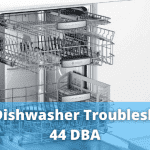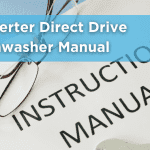Table of Contents
A dishwasher that isn’t washing the dishes can be a significant inconvenience. You wash your dirty plates, and they still appear unclean! There are several reasons why this might happen, so the first step in resolving it is determining what caused it. We’ll go through some of these causes and how to fix them in this blog article!
10 Solutions To Fix Whirlpool Dishwasher That Isn’t Cleaning Dishes
1. Water Inlet Valve
The water intake valve opens to allow water into the dishwasher. If the valve is blocked or broken, the dishwasher won’t be able to clean dishes adequately. Replace any clogged or malfunctioning water inlet valve immediately. Cleaning the water inlet valve is not recommended—doing so might make it more likely to break down.
2. Water Pump Belt
The water pump belt could be broken or stretched so that it won’t operate properly. On the other hand, the majority of dishwashers do not have a water pump belt; you should look for your model number to see if it has one. To gain access to the water pump belt, remove the lower panel. The water pump belt is located at the bottom of the motor. Replace any damaged or worn water pump belts.
3. Center Wash Arm Assembly
The upper rack’s dishes are cleaned with water from the centre wash arm. If the centre wash arm isn’t working well, the plates in the top rack won’t be properly washed. Food particles can accumulate in the tiny holes of the washing arm over time. The wash arm may be clogged if your dishes are getting filthy. Remove the centre wash arm and any debris from the holes to unclog it. If the wash arm is blocked, replace it. Also, ensure that the centre wash arm assembly is mated correctly with the water supply nozzle.
4. Lower Wash Arm Assembly
The lower wash arm supplies water to the plates in the bottom rack. If the water can’t flow freely through the lower wash arm, dishes in the lower rack won’t be adequately cleaned. In addition, food particles might accumulate in the tiny holes of the wash arm over time. The wash arm may be clogged if your dishes are still dirty after washing. Remove and dislodge any debris from the holes on the lower wash arm to unclog it. If your washer’s lower wash arm is wholly blocked, replace it.
5. Upper Wash Arm Assembly
Water from the lower wash arm is then circulated up to the dishes in the upper rack. If water can’t flow through the upper wash arm properly, the plates in the top rack won’t be washed thoroughly. Over time, food particles accumulate in the tiny holes of the wash arm. The wash arm may be clogged if your dishes are not coming clean. Remove and dislodge any debris from the holes on the upper wash arm to unclog it. If your wash arm is poorly blocked, replace it.
6. Circulation Pump
Like the detergent dispenser, the circulation pump uses a motor and impeller to push water through the wash arms. The dishes will not be cleaned adequately if the circulation pump is broken. If you hear no noise from the motor after the dishwasher has filled or just a humming sound, it could be burned out. First, make sure electricity is reaching the motor. Second, inspect the pump housing for debris to ensure that the impeller can rotate. If electricity comes from the motor and the pump is free of debris, it’s possible that the motor needs to be replaced. Although replacing a circulation pump may be difficult, many do-it-yourselfers have been able to succeed with it.
7. Circulation and Drain Pump Motor
The circulation pump consists of a motor and impeller that drive water up through the wash arms. The dishes will not be cleaned correctly if the circulation pump is defective. If the dishwasher has filled, but there is no noise or humming from the motor, it may be burned out. First, check to see whether electricity reaches the motor. Second, inspect the pump housing for debris to ensure that the impeller can turn. If power is available to the motor, but there is no debris in the pump housing, it’s possible that the motor needs to be replaced. The circulation pump may be difficult to replace. However, many do-it-yourselfers have been successful with this task.
8. Pump and Motor Assembly
An impeller in the motor drives water up through the wash arms. If the pump impeller is broken, damaged, or blocked, dishes will not be adequately cleaned. Confirm that power reaches the circulation pump and motor. If the power goes the pump and motor assembly but does not cause it to operate, replace both components.
9. Wash Impeller
The wash impeller is a tiny plastic blade that forces water up through the wash arms. It may not be enough pressure for the impeller to push water through the wash arms or miss some of its fins if it is broken. On most models, you can replace the wash impeller without taking out the pump and motor assembly. To determine if your impeller is replaceable, go to your manufacturer’s website and look for your model number. If the impeller can’t be replaced separately, you’ll have to buy a new pump and motor assembly.
10. Upper Wash Arm Spinner
The upper wash arm circulates water to the plates in the upper rack. If the water cannot flow freely through the upper wash arm, the dishes on the top shelf will not be properly cleaned. In addition, food particles accumulate over time in the tiny holes of the wash arm. The wash arm on your dishwasher may be clogged if your dishes are coming out unclean. Remove the upper wash arm and remove any debris from the holes to unclog it. If the wash arm is blocked, replace it.








[…] temperature and soil level during the prewash and wash, Sensor Cycle Automatically selects the proper wash and dry settings for each […]